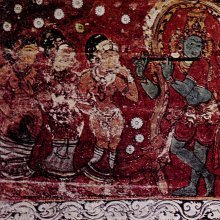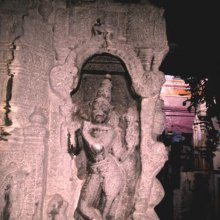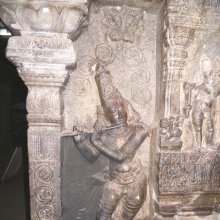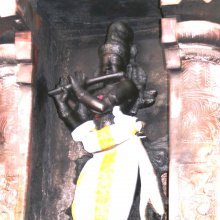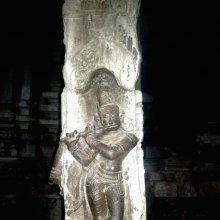Venugopala, Venu-gopala, Veṇugopāla: 2 definitions
Introduction:
Venugopala means something in Hinduism, Sanskrit. If you want to know the exact meaning, history, etymology or English translation of this term then check out the descriptions on this page. Add your comment or reference to a book if you want to contribute to this summary article.
Images (photo gallery)
(+3 more images available)
In Hinduism
Shilpashastra (iconography)
Source: Shodhganga: The significance of the mūla-beras (śilpa)Veṇugopāla is the name of a deity depicted in the Aruṇācaleśvar or Arunachaleswara Temple in Thiruvannamalai (Tiruvaṇṇāmalai) which is one of the Pañcasabhā or “five halls where Śiva is said to have danced”.—Veṇugopāla is the other name for Kṛṣṇa. Veṇugopāla is found to stand in sama posture with the left leg placed in front in svastika (crossed). He is found with four hands. The upper hands hold cakra and śaṅkha in kartarīmukha-hasta. The lower right and left hands hold siṃha-karṇa near the right side of the mouth as if holding a flute. In dance, Veṇugopāla is depicted as standing in sama with the left leg placed in front in svastika and holding kapittha near the right side of the mouth in both the lower hands and kartarīmukha in both the upper hands. Rādhā and Rukmini are found on the either side of the lord.

Shilpashastra (शिल्पशास्त्र, śilpaśāstra) represents the ancient Indian science (shastra) of creative arts (shilpa) such as sculpture, iconography and painting. Closely related to Vastushastra (architecture), they often share the same literature.
Languages of India and abroad
Kannada-English dictionary
Source: Alar: Kannada-English corpusVēṇugōpāla (ವೇಣುಗೋಪಾಲ):—[noun] Křṣṇa, as a flute-player.
Kannada is a Dravidian language (as opposed to the Indo-European language family) mainly spoken in the southwestern region of India.
See also (Relevant definitions)
Partial matches: Venu, Gopala.
Starts with: Venugopalapratishtha.
Full-text: Venugopalapratishtha.
Relevant text
Search found 4 books and stories containing Venugopala, Venu-gopala, Veṇugopāla, Veṇu-gopāla, Veṇugōpāla, Veṇu-gōpāla, Vēṇugōpāla, Vēṇu-gōpāla; (plurals include: Venugopalas, gopalas, Veṇugopālas, gopālas, Veṇugōpālas, gōpālas, Vēṇugōpālas). You can also click to the full overview containing English textual excerpts. Below are direct links for the most relevant articles:
Later Chola Temples (by S. R. Balasubrahmanyam)
Temples in Chennur < [Chapter XVI - Temples of Rajendra III’s Time]
Temples in Srirangam < [Chapter XVIII - Chola-Hoysala Phase]
Temples in Srirangam < [Chapter II - Temples of Kulottunga I’s Time]
Tiruppavai-Sri Andal < [July – September, 1999]
The Beggar of Love < [July – September, 1989]
Who’s Who Among Our Contributors < [April – June, 2000]
Srila Gurudeva (The Supreme Treasure) (by Swami Bhaktivedanta Madhava Maharaja)
Residing at Govardhana in Kãrtika < [Chapter 2.19 - The Concluding Transcendental Pastimes]
Pallava period (Social and Cultural History) (by S. Krishnamurthy)
Vaishnavism during the Pallava period < [Chapter 3 - Socio-Religious Life]

